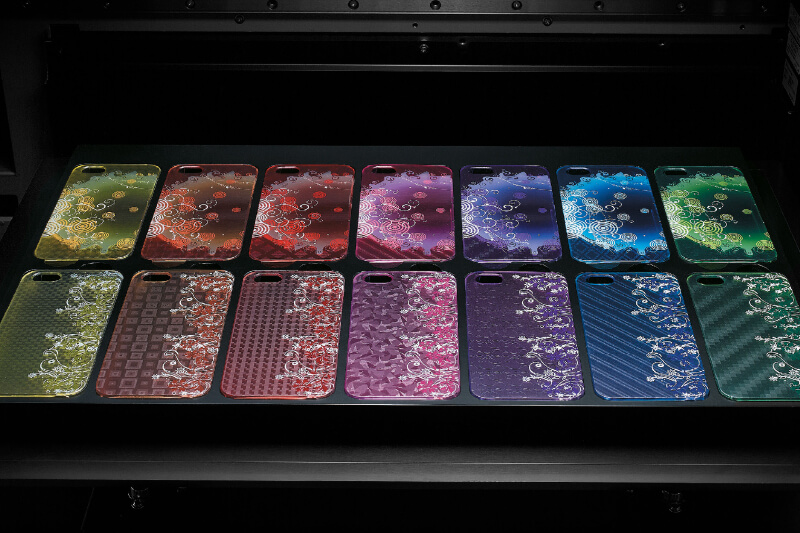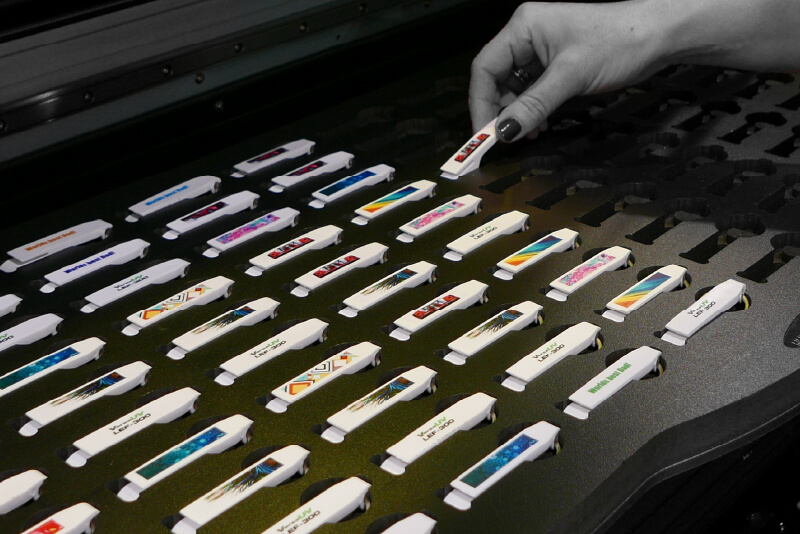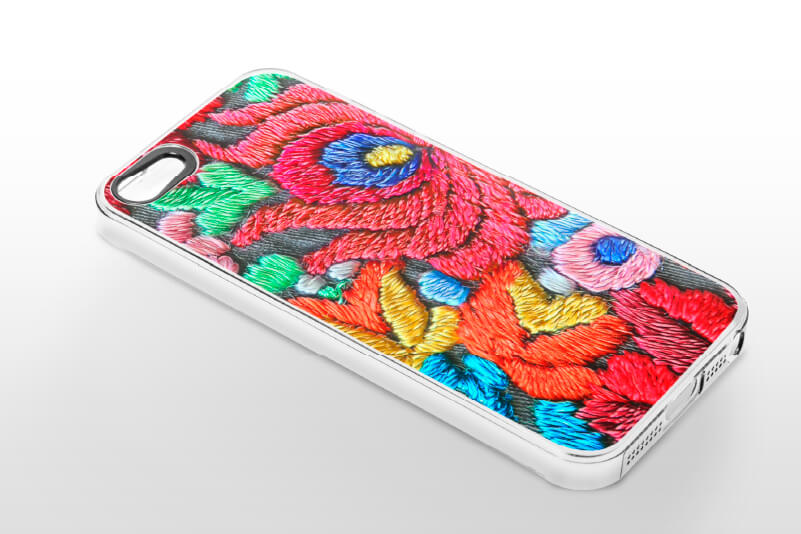Traditional methods of object customisation, like screen printing and pad printing, require a lot of preparation, set-up, and investment. Lead times are long, and amends and errors are costly.
By using digital printers, producers can freely move away from expensive manual processes and adopt more flexible, less costly approaches like UV printing. Because of this, object customisation is more accessible to the end customer and thus the demand has grown at an astonishing rate.
In this article, we’ll tell you what you need to get started with a UV printing solution and give you a few examples of products you could start making.

What is UV Printing?
Although other digital printing inks, like eco-solvent, can be used for direct-to-object printing, UV printing is still the most popular method today. Simply put, the printer applies UV ink from the print head and a built-in UV lamp cures the ink immediately at a low temperature.
Among the other advantages of UV printing, this means no drying time needs to be accounted for in the workflow and that heat-sensitive items like electronic devices can be directly customised without the risk of damage.
What Do You Need to Get Started with Flatbed UV Printing?
The flatbed UV printer you choose will mainly depend on the volume of work you will be producing. In all cases, the device consists of a flat bed upon which the object rests as it is printed and a print carriage which delivers the ink.
When it comes to choosing the best UV printer for your business, the main thing you will need to consider is the volume of work you’ll be producing or the size of the objects. By investing in a printer with a larger bed, you can print larger items or print a larger quantity in a single print run.
Ink
UV ink is the most popular type of ink available for object customisation owing to its ability to bond to a wide range of substrates. For some sensitive applications, such as products than come into contact with food, printing direct with eco-solvent ink may be a better option
Besides the type of ink, you also have a choice between the colours and varieties installed in your device. You may wish to reproduce brand colours more accurately; in which case you can add additional colours besides CMYK. Or you might want to print onto difficult materials like stainless steel or aluminium – in this case, you could add a printable primer as an option.
Blank Items
Of course, you’ll need objects to customise. In this case, the list is too long to mention everything, but popular items to print on include phone cases, keyrings and promotional items like pens, bottle openers and USB drives.
It pays to consider the types of items you will want to print – particularly their thickness as all printers will have a maximum print height and anything larger won’t fit.
You can also add any flat material, like wood, acrylic, canvases, or even ceramic tiles, and produce any number of products from wall art to photo blocks to custom signs.
A Computer
To translate your designs into a format your printer can interpret, you will need a computer with a RIP (raster image processor) installed. This piece of software not only converts the data, but it gives lots of other options to help position your items, manage ink usage, speed up your workflow and tweak the colour accuracy.
A Graphic Design Package
To produce the artwork prior to printing, you will need a graphic design solution, ideally including a bitmap editor (like Adobe Photoshop) and a vector editor (like Adobe Illustrator). Aside from designing for print, these also help with additional print data like white ink areas and gloss ink details.
A Space to Work
One of the biggest advantages of customising objects with a flatbed UV printer is that the production is self-contained. This means that finishing work is minimal, and you only need to make space for the device itself.
Most UV printer operators also use an air filtration unit which reduces the odour from the UV ink and makes for a more pleasant work environment. For smaller UV print devices, the filtration unit usually sits beneath the printer, so you don’t need any additional floor space.
Besides this, you’ll need space to store your blank objects and ink, and an area where you can prepare items for dispatch to your customers.
Additional Tools
As previously mentioned, you will seldom need to finish the item with extra application steps, so you won’t need many additional tools. A roll of low-tack adhesive application sheet can be useful to prepare the bed of the printer, allowing you to print guide-lines for easier positioning of the items.
If you are printing several of the same item in bulk, printing jigs are very useful. These can be purchased from specialist suppliers, or you can make your own jigs with a little ingenuity.

What Can You Print With a UV Printer?
The short answer is: if you can print on it, you can probably sell it. The list of things you can make with direct-to-object printing is massive, but here are a few broad categories to give you some inspiration.
Promotional Items
There are lots of opportunities around producing UV-printed promotional items, whether producing in-house or as a third party. If you’ve ever been to a trade show, a convention or any other event, you will have seen a vast array of UV-printed giveaways like pens, badges and even portable power banks – all of which are possible using UV printers. Promotional items also include branded stationery which is another useful way to position the same product to a different audience.
Personalised Products
There is an increasing demand for personalisation across virtually all markets. The B2C audience wants unique products from personalised phone cases to acrylic photo blocks and much more besides. As for the B2B market, they are looking for ways to offer a personalisation service along with the products they already sell, like custom gaming equipment or monogrammed golf balls.
Limited Edition Products
Companies are always looking for ways to keep their offering fresh and relevant, and to engage their audiences with rapid, viral campaigns. UV printing gives them the freedom to experiment with short runs of products designed to promote a trend. Since the investment is low, they can confidently create smaller batches and generate a high level of customer demand.
If you’re thinking about starting with UV printing, get in contact with an expert to discuss solutions, training and much more.

